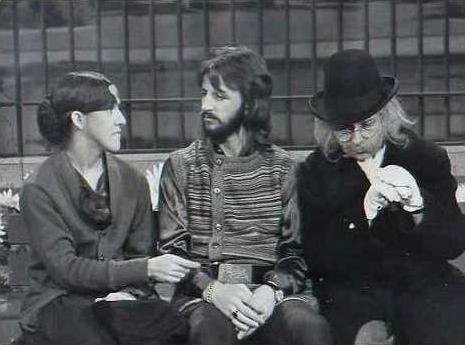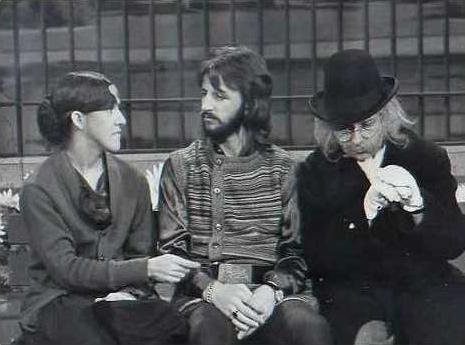If you recognize such catchphrases as You bet your sweet bippy or Verrry interesting or Here come da judge or Look that up in your Funk & Wagnalls or Sonny Tufts! or the ever popular Sock it to me, then theres a fan of Rowan & Martins Laugh-In lurking somewhere in your sphere.
A relic of the 1960s but a nutty and mirthful relic Laugh-In was a TV variety show that stretched that genre. It was unlike anything else on the air and became an almost immediate cultural touchstone.
And fans have been clamoring to see it again, especially since two best-of DVD sets released a dozen years ago and, with just six episodes each, are now out of print.
So get ready for all six seasons of Rowan & Martins Laugh-In: The Complete Series (Time Life, 1968-73, 38 discs, 140 episodes, pilot episode, featurettes, bloopers, 16-page booklet), available at timelife.com.
Initially, viewers in 1968 werent quite sure what to make of Rowan & Martins Laugh-In, but after a few weeks the show proved to be just traditional enough to be tentatively embraced by middle-aged adults, and just subversive and psychedelic enough to be wholly embraced by their teenage and 20-something kids.
The traditional aspect came from the polished, suit-and-tie-clad comedy team named in the title, questioning straight-man Dan Rowan, with an ever-present cigarette in his hand (or sometimes a pipe), and Dick Martin, his off-kilter partner whose obtuse responses provided the punchlines. Both were in their mid-40s when the show began.
The duo was familiar to television audiences from stand-up guest appearances on variety shows of the 1950s and 60s, and they even starred in a theatrical Western comedy in 1958, Once Upon a Horse. (Why doesnt somebody release that on home video?)
But it was Laugh-In that made stars of Rowan and Martin, as they hosted each episode and participated in skits, but they also took on an observational role, just two regular guys wandering through the madness of the rest of the show, as if they were tourists that had unintentionally stumbled into Haight-Ashbury.
The format was willy-nilly, to be sure, but it was never dull, with everything rapidly paced. Today, some of the topical and cultural gags feel dated, to be sure, but theres also plenty of material that evokes chuckles.
Each show begins with announcer Gary Owens (a popular Los Angeles deejay at the time) making nonsensical pronouncements while standing in an old-fashioned radio studio, speaking into a large stand-up microphone with a hand cupped over his ear.
In and around Owens shtick and all throughout the show, for that matter are seconds-long shots of cast members and guests spouting non sequiturs, double-entendres and political jokes, or performing blackout skits.
The longer sketches range from satirical to silly, with announced and unannounced guest stars popping in and out, as well as filmed outdoor routines and recurring bits that became mainstays of the show.
An example of the latter is The Party, a sequence that follows Rowan and Martins initial monologue. They invite the audience to join them as they enter a room where dancing and conversation are in progress, backed by hippy-dippy pop music. Every so often the music stops and someone gets a closeup to offer something witty, smart, zany or just odd.
Fan-favorites soon emerged from the large cast Ruth Buzzi, most notable as dowdy spinster Gladys Ormphby, with a hairnet knotted on her forehead, and Arte Johnson, who would often play an elderly lech who approached her in a park, much to his regret. Johnson earned a following for his World War II-era German soldier, creeping behind a bush to ominously intone, Verrry interesting.
Judy Carne would dance the Frug and get hit on the head, as the official sock it to me girl; brassy Jo Anne Worley would laugh loudly at her own jokes; Henry Gibson would hold an oversized flower while reciting offbeat poetry; and flamboyant Alan Seus would play a clueless sports announcer, among other characters.
But the two who really broke out were Goldie Hawn and Lily Tomlin.
Hawn was giggly, bubbly and utterly winning. The short-haired blonde was the youngest of the cast, coming aboard just three episodes into the first season as the ditziest of the ditzy and she was still on the show when she won her best supporting actress Oscar for Cactus Flower the next year.
Tomlin joined up toward the end of the third season, and two of her characters really caught on: Edith Ann, a little girl in a huge rocking chair who ended her monologues by saying, And thats the truth, followed by a raspberry, and cheeky telephone operator Ernestine, who would say, while making a call, One ringy-dingy, two ringy-dingies.
There were also musical interludes, but always laced with comedy, ranging from the Bee Gees to Strawberry Alarm Clock to Tiny Tim.
And each episode would end with cast members popping out of windows in a colorful wall to banter some more under the end credits and then still more bits of business would follow the credits.
Laugh-In surprised everyone by shooting to No. 1 in the ratings almost immediately, and it stayed in the top spot for its first two seasons.
And that may explain how the show was able to wrangle so many top guest stars to come on and be fleetingly foolish, including John Wayne, Flip Wilson, Carol Burnett, Sammy Davis Jr., Jack Benny, Rita Hayworth, Tim Conway, Kirk Douglas, Sally Field, Greer Garson, Bob Hope, Jack Lemmon, Janet Leigh, Raquel Welch, Rod Serling, Mel Brooks, Peter Sellers, Diana Ross, Cher, Vincent Price, Danny Kaye, Orson Welles, Ringo Starr and far too many more to name.
Even Billy Graham and Truman Capote showed up, though perhaps the best remembered is President Richard Nixon, intoning, Sock it to me?"
For baby boomers like me, this is happy nostalgia, but I make no apologies. Hey, it made me laugh. And who can ask for more than that?
A relic of the 1960s but a nutty and mirthful relic Laugh-In was a TV variety show that stretched that genre. It was unlike anything else on the air and became an almost immediate cultural touchstone.
And fans have been clamoring to see it again, especially since two best-of DVD sets released a dozen years ago and, with just six episodes each, are now out of print.
So get ready for all six seasons of Rowan & Martins Laugh-In: The Complete Series (Time Life, 1968-73, 38 discs, 140 episodes, pilot episode, featurettes, bloopers, 16-page booklet), available at timelife.com.
Initially, viewers in 1968 werent quite sure what to make of Rowan & Martins Laugh-In, but after a few weeks the show proved to be just traditional enough to be tentatively embraced by middle-aged adults, and just subversive and psychedelic enough to be wholly embraced by their teenage and 20-something kids.
The traditional aspect came from the polished, suit-and-tie-clad comedy team named in the title, questioning straight-man Dan Rowan, with an ever-present cigarette in his hand (or sometimes a pipe), and Dick Martin, his off-kilter partner whose obtuse responses provided the punchlines. Both were in their mid-40s when the show began.
The duo was familiar to television audiences from stand-up guest appearances on variety shows of the 1950s and 60s, and they even starred in a theatrical Western comedy in 1958, Once Upon a Horse. (Why doesnt somebody release that on home video?)
But it was Laugh-In that made stars of Rowan and Martin, as they hosted each episode and participated in skits, but they also took on an observational role, just two regular guys wandering through the madness of the rest of the show, as if they were tourists that had unintentionally stumbled into Haight-Ashbury.
The format was willy-nilly, to be sure, but it was never dull, with everything rapidly paced. Today, some of the topical and cultural gags feel dated, to be sure, but theres also plenty of material that evokes chuckles.
Each show begins with announcer Gary Owens (a popular Los Angeles deejay at the time) making nonsensical pronouncements while standing in an old-fashioned radio studio, speaking into a large stand-up microphone with a hand cupped over his ear.
In and around Owens shtick and all throughout the show, for that matter are seconds-long shots of cast members and guests spouting non sequiturs, double-entendres and political jokes, or performing blackout skits.
The longer sketches range from satirical to silly, with announced and unannounced guest stars popping in and out, as well as filmed outdoor routines and recurring bits that became mainstays of the show.
An example of the latter is The Party, a sequence that follows Rowan and Martins initial monologue. They invite the audience to join them as they enter a room where dancing and conversation are in progress, backed by hippy-dippy pop music. Every so often the music stops and someone gets a closeup to offer something witty, smart, zany or just odd.
Fan-favorites soon emerged from the large cast Ruth Buzzi, most notable as dowdy spinster Gladys Ormphby, with a hairnet knotted on her forehead, and Arte Johnson, who would often play an elderly lech who approached her in a park, much to his regret. Johnson earned a following for his World War II-era German soldier, creeping behind a bush to ominously intone, Verrry interesting.
Judy Carne would dance the Frug and get hit on the head, as the official sock it to me girl; brassy Jo Anne Worley would laugh loudly at her own jokes; Henry Gibson would hold an oversized flower while reciting offbeat poetry; and flamboyant Alan Seus would play a clueless sports announcer, among other characters.
But the two who really broke out were Goldie Hawn and Lily Tomlin.
Hawn was giggly, bubbly and utterly winning. The short-haired blonde was the youngest of the cast, coming aboard just three episodes into the first season as the ditziest of the ditzy and she was still on the show when she won her best supporting actress Oscar for Cactus Flower the next year.
Tomlin joined up toward the end of the third season, and two of her characters really caught on: Edith Ann, a little girl in a huge rocking chair who ended her monologues by saying, And thats the truth, followed by a raspberry, and cheeky telephone operator Ernestine, who would say, while making a call, One ringy-dingy, two ringy-dingies.
There were also musical interludes, but always laced with comedy, ranging from the Bee Gees to Strawberry Alarm Clock to Tiny Tim.
And each episode would end with cast members popping out of windows in a colorful wall to banter some more under the end credits and then still more bits of business would follow the credits.
Laugh-In surprised everyone by shooting to No. 1 in the ratings almost immediately, and it stayed in the top spot for its first two seasons.
And that may explain how the show was able to wrangle so many top guest stars to come on and be fleetingly foolish, including John Wayne, Flip Wilson, Carol Burnett, Sammy Davis Jr., Jack Benny, Rita Hayworth, Tim Conway, Kirk Douglas, Sally Field, Greer Garson, Bob Hope, Jack Lemmon, Janet Leigh, Raquel Welch, Rod Serling, Mel Brooks, Peter Sellers, Diana Ross, Cher, Vincent Price, Danny Kaye, Orson Welles, Ringo Starr and far too many more to name.
Even Billy Graham and Truman Capote showed up, though perhaps the best remembered is President Richard Nixon, intoning, Sock it to me?"
For baby boomers like me, this is happy nostalgia, but I make no apologies. Hey, it made me laugh. And who can ask for more than that?

